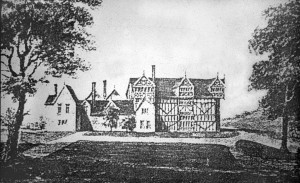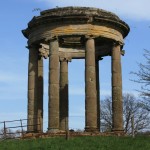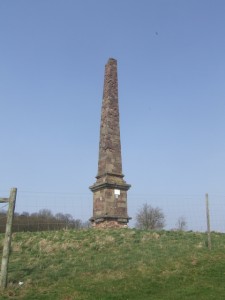The Lytteltons: Lords of the Manor from 1564 onwards
The Lytteltons had been in North Worcestershire some two and a half centuries before buying the manor of Hagley. It is almost certain that they originated from the Littletons near Evesham i.e. North, Middle and South Littleton.
About 1270, a Thomas de Luttelton40 married the daughter of Philip de Frankley. It is not clear how the Lutteltons gained control of Frankley manor but another Thomas de Luttelton and his wife Matilda were granted the manor in 1410.
Sir John Littelton bought Hagley from Sir John St.Leger in 1564 but continued to live in the moated manor house at Frankley, as did his son Gilbert, as far as is known. Gilbert’s eldest son, John, married Meriel Bromley, the daughter of Sir Thomas Bromley, Lord Chancellor of England in 1590.
It may be assumed that John and Meriel started their married life in the old hall, which was sited on the cricket square, adjacent to the parish church. Six of their eight children were baptized at Hagley, their names appearing in the first parish register between 1593 and 1599.
Another connection with this period is the splendid carved oak over-mantle from the great parlour of the old hall which can be seen in the barrel room of the present hall. The carving includes the arms of both the Lytteltons and the Bromleys.
In 1601, John Lyttelton41 was involved with the Earl of Essex in a rebellion, only two years after his father’s death and his inheritance of the estates. This so called rebellion, which does not seem to have got beyond the protest meeting stage, ended with many of the plotters being condemned, imprisoned and executed. John beat the executioner by dying in prison. Queen Elizabeth I seized the estates and it was only at her death in 1603 that matters were rectified.
Meriel met the new King James I at Doncaster, en route from Edinburgh to London, and successfully pleaded with him for the return of the manors of Hagley, Cradley, Oldswinford and others in Shropshire and Staffordshire.
According to Dr.T.Nash in his History of Worcestershire, Meriel paid off £20,000 of debts and only sold land to the value of £8,854. A remarkable achievement by any standards but when compared with today’s values, even more remarkable.
Only two years later, Hagley was again making the news. Late in 160542 the attempt to blow up the Houses of Parliament had failed and the conspirators were on the run. Two of them, Robert Winter and Stephen Littelton hid at Hagley but were betrayed by an under cook, captured and taken to London. Fortunately, Meriel was not in Hagley at the time so could in no way be accused of assisting the fugitives.
The rest of Meriel’s life seems to have been fairly uneventful and she died in April 1630, and is buried in the churchyard under a table tomb. A memorial erected by her great, great grandson, the Bishop of Carlisle in 1769, can be found at the west end of Hagley church. The language is quite fulsome as one might expect for the period and sets out the gratitude of the family for her life.
Meriel’s eldest son, Thomas, was created a baronet in 1618 when he was about 25 and must by then have taken over the running of the estates.
Sir Thomas was married to Catherine Crompton about 1618 and they raised a very large family. Sir Thomas, in addition to being a good father, was also a strong Royalist and, in 1642, he was commissioned as a Colonel of the trained bands and volunteers.
He was also appointed Governor of Bewdley. Colonel Fox, one of Cromwell’s less orthodox officers, approached Bewdley at night, gained access to the town and took Sir Thomas prisoner. Fox was soon relieved of his prisoner by Parliament and was sent to the Tower of London. Earl Essex (son of the Essex involved forty years before with John Lyttelton) arranged to stand bail for Sir Thomas. However, Sir Thomas was soon back in the Tower and probably, was not released until 1646.
A further indignity occurred in 1642 when Prince Rupert garrisoned Frankley Manor House, the old family home, and then destroyed it to prevent the Parliamentarians making any use of it.
The Tower does not appear to have been a healthy place as Sir Thomas died in 1650 at the age of 54 and is buried in Worcester Cathedral with his wife, who outlived him by 16 years.
After Catherine was widowed, she moved from Hagley to Arley and rebuilt Arley Manor House. Arley had come into the Lytteltons’ possession when, in 1470, one of the daughters of the then owner, Sir William Burley, married Judge Lyttelton.
Sir Henry succeeded his father as second baronet. He was the fifth son. The first and fourth had drowned at Oxford and the second and third had died young. He was married, firstly to Philadelphia Cary who died in 1663 and secondly, to Elizabeth, daughter of Viscount Newport.
Like his father, he was a Royalist and, in 1651, following the battle of Worcester, he was arrested for having a small arsenal of guns at Hagley. The defence was that, as High Sheriff of Worcestershire, they were necessary for maintaining law and order. Unfortunately his argument was not accepted and, like his father, he spent two years in the Tower.
Arley Hall seems to have been the centre of activity for Sir Henry until his death at the age of 69. There were no children and he was succeeded by his brother Charles in 1693.
Sir Charles seems to have been a man of many parts. He defended Colchester for the King in 1648 and was sent to the Tower by Cromwell. He was, in turn, Governor of Jamaica 1662-4, Governor of Harwich 1667-72 and M.P. for Bewdley 1685-89.
He also had two marriages. The first to Catherine Fairfax and the second to Ann Temple. Between them these two ladies had thirteen children.
As far as Hagley is concerned, Sir Charles is believed to have carried out some modernization on the old hall and its north-east corner at the end of the seventeenth century, and to have “re-imparked” the park in 1694. Both these events would be at the time that he inherited the baronetcy and suggest his preference for Hagley rather than Arley. However, when he died in 1716, he was buried at Arley, as indeed his brother had been.
Sir Thomas Lyttelton was the fifth son of Sir Charles and the fourth baronet. He married Christian Temple in 1708. Her brother became Viscount Cobham and it is this connection that eventually brought the title to Hagley and the Lytteltons.
Sir Thomas was involved in politics as a Whig when Sir Robert Walpole was Prime Minister. He served as M.P. for Worcestershire for 13 years from 1721, and later for Camelford in Cornwall. He was also one of the Lords Commissioners of the Admiralty for 14 years.
About 1747 he caused the castle and the rotunda to be built in Hagley Park. Both of these follies are attributed to Sanderson Miller and the stones for the castle are believed to have been brought from Halesowen Abbey.
In spite of his busy political life he found time to father twelve legitimate children and one who was illegitimate, known as Admiral Tom Smith.
Admiral Smith lived at Rockingham Hall and is credited with building the obelisk, better known as the Hagley Monument.
The Hagley Monument on Wychbury Hill is visible for many miles. It was erected by Admiral Tom Smith, a half brother of the first Lord Lyttelton, in the mid-18th century. It is said to be like the inhabitants of Hagley – “stuck up for no reason and not quite straight”.
A memorial tablet to both Sir Thomas and his wife can be seen in St.John’s church. The plaque gives a generous summary of their lives and was erected by their eldest son, Sir George.
Sir George succeeded his father in 1751. Like his father, he was involved in politics. Early in his career he was M.P. for Old Sarum, one of the rotten boroughs that vanished following the Parliamentary Reform Act of 1832. Failure to be elected as M.P. for Worcestershire did not put him off as he became M.P. for Okehampton 1735-56. During this period he was also a Lord of the Treasury 1744-54, and Chancellor of the Exchequer 1755 in Pitt’s government. This last appointment was not over successful and he was created Baron Lyttelton of Frankley in the following year.
Other important appointments included that as Secretary to Fredrick, Prince of Wales in 1737. This appointment led to a friendship which ended with the Prince’s death in 1751, nine years before his father, George II. The Prince’s pillar in Hagley Park is the only known public monument to Prince Fredrick.
Lord George was married twice, first to Lucy Fortescue, who died in 1747 aged 29. A monument to the memory of Luciae, is in Hagley church. His second marriage to Elizabeth Rich was not a success and she was ordered out of Hagley.
Without any doubt, Lord George’s lasting monuments are the Palladian style of Hagley Hall and Hagley Park, with its follies and features. The hall was built 1754-60 by Sanderson Miller with the help from others according to Pevsner. Sanderson Miller is also credited with the layout of the park.
There are monuments in the park to literary giants, including Milton, Pope and Thompson who enjoyed patronage from Lord George. Shenstone, the Lyttelton’s neighbour from the Leasowes in Halesowen is also remembered with an urn in front of the hall.
Known as the Good Lord, George’s own literary efforts were a little pedestrian. A biography of Henry II took 27 years to complete.
Thomas, the second baron, known as the Bad Lord, was perhaps unlucky but, unfortunately for him, comparisons with his father were not favourable. He married Aphia Witts, who outlived Thomas by 61 years. He died at only 35 without any direct heirs. One outcome of this was that the Arley estate, which had come into the family by marriage in the 15th century, was left to his sister Lucy, the wife of Sir Annesley Viscount Valentia.
With no male heir it was necessary for the succession to go back a generation to the sixth son of Sir Thomas, who was William Henry. In 1779 he was already Lord Westcote and only inherited the estates not the Barony of Frankley, his barony was recreated in 1794.
William Henry was, like many of his family, a busy man. He trained for the bar at the Inner Temple, did two stints as M.P. for Bewdley, was Ambassador to Portugal and Recorder from 1780 until his death in 1808. Between spells as an M.P. he managed to fit in two Governorships of South Carolina and Jamaica. Added to the list of doubles, he first married Mary Macartney, who died in Jamaica, and secondly Caroline Bristow.
The eldest son of William Henry and Mary was George Fulke, who unfortunately suffered from mental illness and for much of his time as the second Baron of the second creation was unable to contribute to the running of the family estates.
In turn, George Fulke was succeeded by his half-brother, another William Henry. He was the M.P. for Worcester for 13 years from 1807 sitting as a Liberal. He married Lady Sarah Spencer, daughter of Earl Spencer in 1813. Five years after succeeding to the title he served as Lord Lieutenant for Worcestershire, until his death in 1837.
George William inherited the title and estates at the early age of 20 and married his first wife, Mary Glynne, two years later. She was the mother of a very large family and it was probably this that contributed to her early death after only eighteen years of marriage. Some twelve years later George William married Sybella Harriet, a much younger woman who was not even born at the time of the first wedding.
Once more there is involvement in politics and public service. In 1845 he was Principal of Queens College, the following year he was appointed Under Secretary of State for the Colonies and in 1853 he was founder President of the Birmingham and Midland Institute. This last position is one that many members of the family have subsequently held.
As Lord Lieutenant of Worcestershire he made a great impression and a collection was made as a tribute to him. The outcome was that the parish church was very largely rebuilt between 1856 and 1865.
The Lytteltons have been patrons of the parish church since buying the manor in 1564 and in the late 1840s a tricky situation arose. The living was vacant and the obvious choice was the Rev.William Henry Lyttelton, a younger brother of George William. The former was very low church while the patron tended towards the opposite direction. Fortunately for family unity, common sense prevailed and in 1847, William Henry was appointed as rector.
Charles George succeeded his father in 1876 as fifth baron and later in the century, succeeded a distant relation as the eighth Viscount Cobham. He was married to Mary Cavendish.
John Cavendish (1880-1949), Charles John (1909-1977), John (1943-2006) and Christopher Charles (1947) have succeeded in turn and each has made his contribution to both the life of the local community and wider spheres in various ways, following the family traditions over many centuries.
40Nash History of Worcestershire Vol. I family tree opposite p.495
41Nash History of Worcestershire Vol. I pp.495-98
42Nash History of Worcestershire Vol. I p.491
*John M,2009.Geograph:Obelisk on Wychbury Hill. [online] Available at: http://www.geograph.org.uk/photo/1214561 [Accessed 03 Jun 2011].





